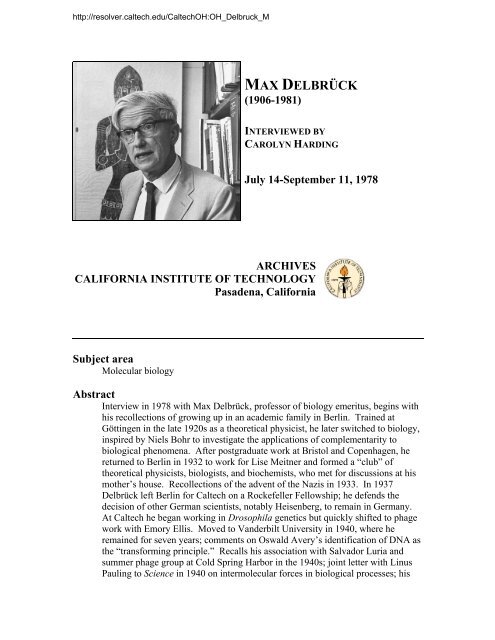Interview with Max Delbruck - Caltech Oral Histories
Interview with Max Delbruck - Caltech Oral Histories
Interview with Max Delbruck - Caltech Oral Histories
Create successful ePaper yourself
Turn your PDF publications into a flip-book with our unique Google optimized e-Paper software.
http://resolver.caltech.edu/<strong>Caltech</strong>OH:OH_<strong>Delbruck</strong>_M<br />
MAX DELBRÜCK<br />
(1906-1981)<br />
INTERVIEWED BY<br />
CAROLYN HARDING<br />
July 14-September 11, 1978<br />
ARCHIVES<br />
CALIFORNIA INSTITUTE OF TECHNOLOGY<br />
Pasadena, California<br />
Subject area<br />
Molecular biology<br />
Abstract<br />
<strong>Interview</strong> in 1978 <strong>with</strong> <strong>Max</strong> Delbrück, professor of biology emeritus, begins <strong>with</strong><br />
his recollections of growing up in an academic family in Berlin. Trained at<br />
Göttingen in the late 1920s as a theoretical physicist, he later switched to biology,<br />
inspired by Niels Bohr to investigate the applications of complementarity to<br />
biological phenomena. After postgraduate work at Bristol and Copenhagen, he<br />
returned to Berlin in 1932 to work for Lise Meitner and formed a “club” of<br />
theoretical physicists, biologists, and biochemists, who met for discussions at his<br />
mother’s house. Recollections of the advent of the Nazis in 1933. In 1937<br />
Delbrück left Berlin for <strong>Caltech</strong> on a Rockefeller Fellowship; he defends the<br />
decision of other German scientists, notably Heisenberg, to remain in Germany.<br />
At <strong>Caltech</strong> he began working in Drosophila genetics but quickly shifted to phage<br />
work <strong>with</strong> Emory Ellis. Moved to Vanderbilt University in 1940, where he<br />
remained for seven years; comments on Oswald Avery’s identification of DNA as<br />
the “transforming principle.” Recalls his association <strong>with</strong> Salvador Luria and<br />
summer phage group at Cold Spring Harbor in the 1940s; joint letter <strong>with</strong> Linus<br />
Pauling to Science in 1940 on intermolecular forces in biological processes; his
http://resolver.caltech.edu/<strong>Caltech</strong>OH:OH_<strong>Delbruck</strong>_M<br />
reaction to 1945 publication of Erwin Schrödinger’s What is Life? Returned to<br />
<strong>Caltech</strong> in 1947 as professor of biology; comments on activities of Biology<br />
Division under chairmen George W. Beadle and Ray Owen, and the<br />
psychobiology of Roger Sperry. Recalls 1953 Watson-Crick discovery of the<br />
structure of DNA; comments on Watson as director of Cold Spring Harbor and on<br />
The Double Helix. Comments on receiving (<strong>with</strong> Luria and Alfred Hershey) the<br />
1969 Nobel Prize in Physiology or Medicine. Recalls his later work on<br />
Phycomyces. The interview ends <strong>with</strong> Delbrück’s overview of the history of<br />
German science and its travails under the Nazis, and recollections of his postwar<br />
visits there.<br />
Administrative information<br />
Access<br />
The interview is unrestricted.<br />
Copyright<br />
Copyright has been assigned to the California Institute of Technology © 1979.<br />
All requests for permission to publish or quote from the transcript must be<br />
submitted in writing to the University Archivist.<br />
Preferred citation<br />
Delbrück, <strong>Max</strong>. <strong>Interview</strong> by Carolyn Harding. Pasadena, California, July 14-<br />
September 11, 1978. <strong>Oral</strong> History Project, California Institute of Technology<br />
Archives. Retrieved [supply date of retrieval] from the World Wide Web:<br />
http://resolver.caltech.edu/<strong>Caltech</strong>OH:OH_<strong>Delbruck</strong>_M<br />
Contact information<br />
Archives, California Institute of Technology<br />
Mail Code 015A-74<br />
Pasadena, CA 91125<br />
Phone: (626)395-2704 Fax: (626)793-8756<br />
Email: archives@caltech.edu<br />
Graphics and content © California Institute of Technology.
http://resolver.caltech.edu/<strong>Caltech</strong>OH:OH_<strong>Delbruck</strong>_M<br />
Caricature of <strong>Max</strong> Delbrück by Hans Gloor, 1950s.
http://resolver.caltech.edu/<strong>Caltech</strong>OH:OH_<strong>Delbruck</strong>_M<br />
Errata:<br />
p. 2: “Preussiche Jahrbücher”—Correct spelling is Preussische.<br />
p. 6 fn: Should be Schweigermutter (one word) and im neuen Haus.<br />
p. 26: “He’s still alive”—Hans Kienle died in 1975.<br />
p. 63: “tobbaco mosiac virus”—Correct spelling is tobacco mosaic virus.
http://resolver.caltech.edu/<strong>Caltech</strong>OH:OH_<strong>Delbruck</strong>_M<br />
Tom Lauritsen, <strong>Max</strong> Delbrück, Niels Bohr and Paul Epstein enjoy a moment on <strong>Caltech</strong>’s sunny<br />
campus in June, 1959. <strong>Caltech</strong> Archives.<br />
Click on the image to listen to Delbrück’s description of Bohr’s<br />
mishap during his 1932 Berlin lecture

















